Tropical fruits should definitely be on your list of fun foods to try while traveling and even while at home!
One of my favorite things to do when we travel is visiting outdoor markets or even grocery stores. It’s a great place to try new things and purchase some tasty souvenirs. But sometimes my favorite treats aren’t always items you can take back home with you on a plane, such as tropical fruit.
While traveling throughout Central America and Asia, as well as my home state of Florida, I’ve had the opportunity to taste some delicious and truly unique tropical fruits. It’s such a treat to try something you’ve never tasted before!
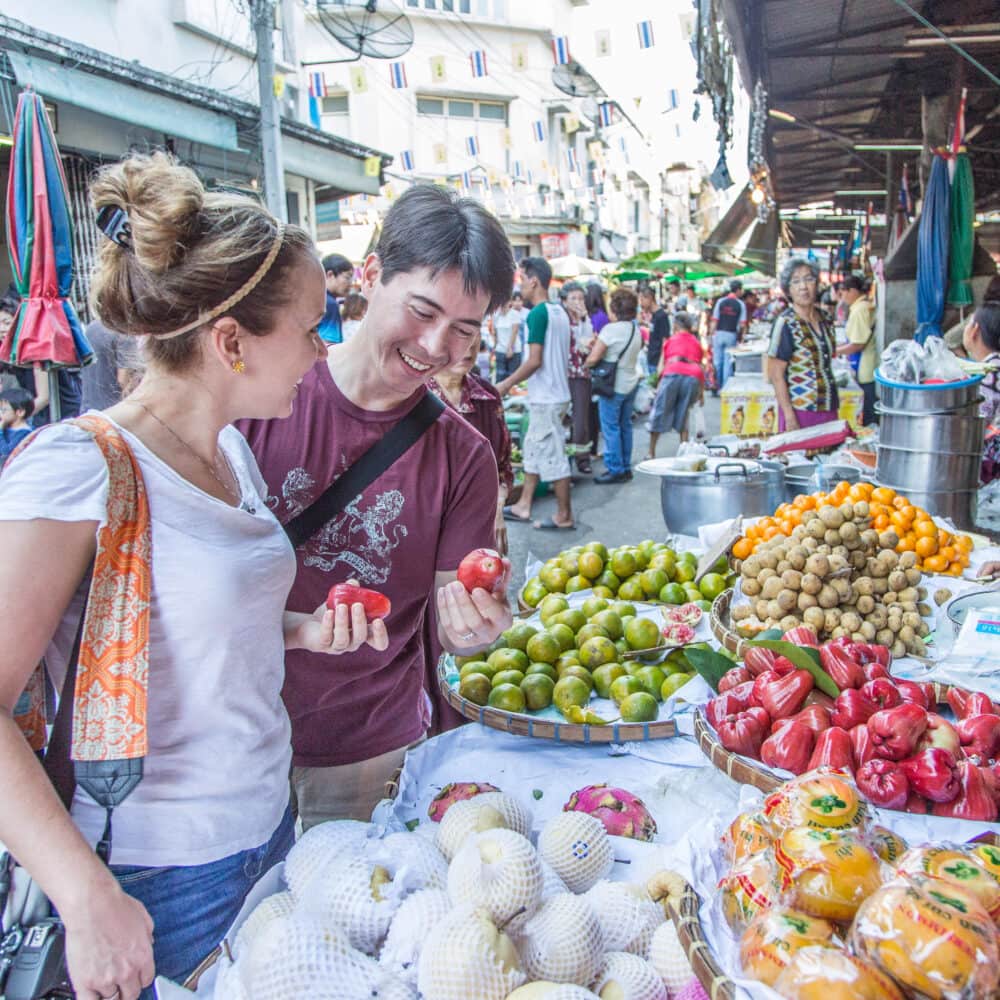
Rachelle and Pete at a tropical fruits market in Thailand.
What Is Considered Tropical Fruit?
Tropical fruits are grown in regions surrounding the Equator, as far north as the Tropic of Cancer and as far south as the Tropic of Capricorn. Essentially, the tropics. Think of places like Hawaii, Mexico, the Caribbean, Central and South America, and Asia as tropical. Florida, though a little further north of the tropics, also grows lots of tropical fruit due to it’s subtropical climate and being surrounded by the ocean.
Some tropical fruits, such as coconut, pineapple, and bananas, are quite common. And others, such as guama and mangosteen, are a bit more difficult to find outside of their growing regions.
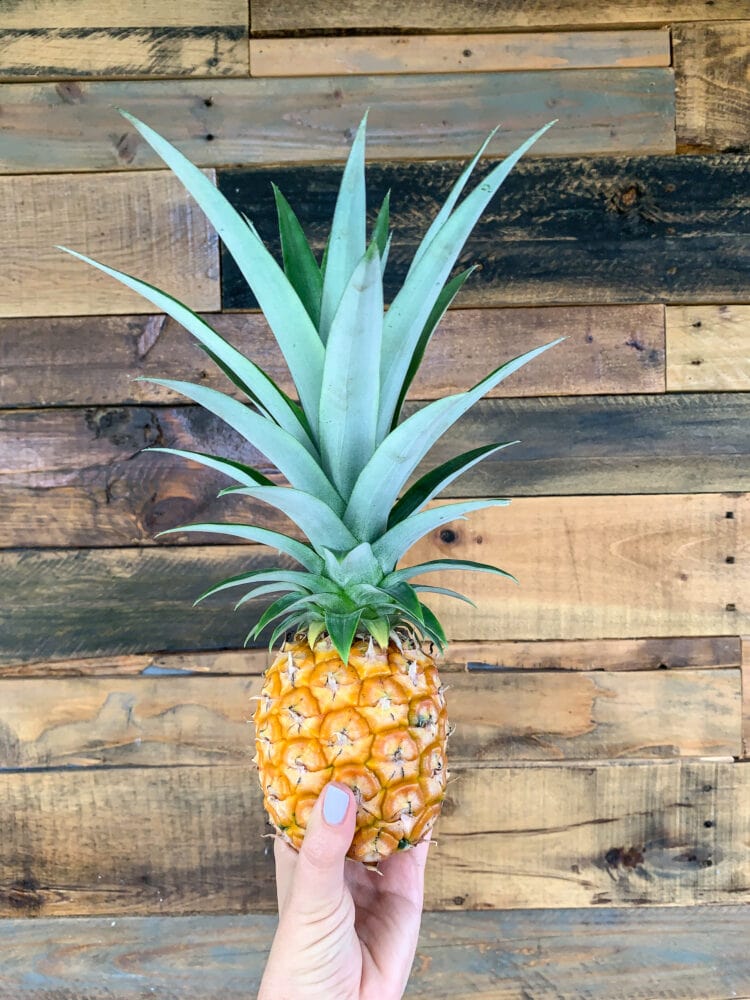
Small homegrown pineapple from our backyard.
An Edible Bucket List
Creating a list of the best tropical fruit available is an impossible task since it depends on personal taste preferences and availability. And then you could even narrow it down to specific varieties of fruits. But with over 500 varieties of mango alone, you’d need a guide book and several lifetimes to try them all.
Personally, my favorite tropical fruits are mangosteen, guaba (ice cream bean), and starfruit. I encourage you to scroll through this list of tropical fruits and look for ones you’ve never tasted before. Think of it as an edible bucket list. And once you’ve tried them all, you can pick your personal favorites.
50+ Tropical Fruits You Should Try
Here I have tropical fruits listed alphabetically from A-Z. It includes common fruits you’ve probably heard of, as well as more unique tropical fruits too.
Avocado: Yes, avocados are a fruit! They’re native to Mexico and Central America and have become very popular in the United States due to trends like avocado toast, avocado smoothies, and guacamole. But did you know how avocados got their name? They’re sometimes also known as alligator pear or butter fruit. But the name “avocado” evolved from the Aztec name for the fruit, āhuacatl, which meant “testicle” and was so named for the way the fruit hangs on the tree. Bet you’ll never look at an avocado the same again.
Banana: Bananas are believed to be native to West Africa and New Guinea, and then brought to the Americas by the Portuguese in the early 16th century. The name “banana” is of West African origin, from the Wolof word banana. While the cavendish variety of banana is what you’ll find at your local supermarket, there are different colors and flavors too. Such as the red bananas found in Southeast Asia and Africa, and the vanilla-flavored blue banana from Java.
Black Sapote: The majority of the time, when a fruit is brown and mushy, you can be sure it’s rotten. But that is not the case for black sapote, which is also known as a chocolate pudding fruit. Once it is soft and dark brown and looks like it’s ready to chuck in the trash, black sapote ready to eat! It has a very mild sweet flavor and virtually no scent at all. If you find some black sapote, try our recipe for black sapote bread!
Breadfruit: Breadfruit looks similar to Jackfruit, but only grows to about the size of a large grapefruit. Cooked breadfruit is very potato-like, and tastes a bit like fresh baked bread (which is probably how it got its name)! It’s typically served in curries and stews, so definitely more of a savory fruit. And it’s very filling! The first time I had breadfruit was while visiting a vegan cafe in St Kitts. It was a hearty meal, kind of potato-like and flavored with curry and carrots. Breadfruit is native to New Guinea and the Philippines. But it was brought to the Caribbean in the late-18th-century as a food source for slaves in British colonies which is why it’s popular in Afro-Caribbean cuisine today.
Buddha’s Hand: Buddha’s Hand is a citrus fruit with finger-like sections. Some also say it resembles a small octopus. It’s not typically eaten, but instead used for its fragrant zest which can be used to flavor foods or scent perfumes. Buddha’s Hand is also given as a religious offering in Buddhist temples in Asian countries.
Cactus Pear: Also called prickly pear, this fruit looks like a small pear and grows on the paddle cactus. It must be peeled carefully to remove the tiny cactus spines (as I unfortunately learned after biting into one in Mexico!) Cactus Pear matures to bright colors such as pink, orange, and green. It’s very popular in Mexico where it is called nopales. They’re often used in salads, desserts, drinks, and candies. But they’re also popular in some countries in Europe. Such as in Malta, where I tried a cactus pear liquor called bajtra.
Cherimoya: This fruit can sometimes be confused with custard apples or soursop, but this fruit grows at higher altitudes where it grows in the mountains in Central and South America. It is heart shaped with a smooth, scalloped-like texture and green skin. The flavor has been described as a tangy cross between banana and pineapple.
Chayote: Chayote is a small light green fruit with a mild cucumber-like flavor and can be prepared in any way you might use summer squash. Typically, the tough skin is peeled and the fruit is marinated in lime juice and added to salads or salsas. In Louisiana and Haiti, it’s known as mirliton. And in Australia and Singapore it’s called choko. Chayote looks very similar to guanabana, but has a smoother skin texture.
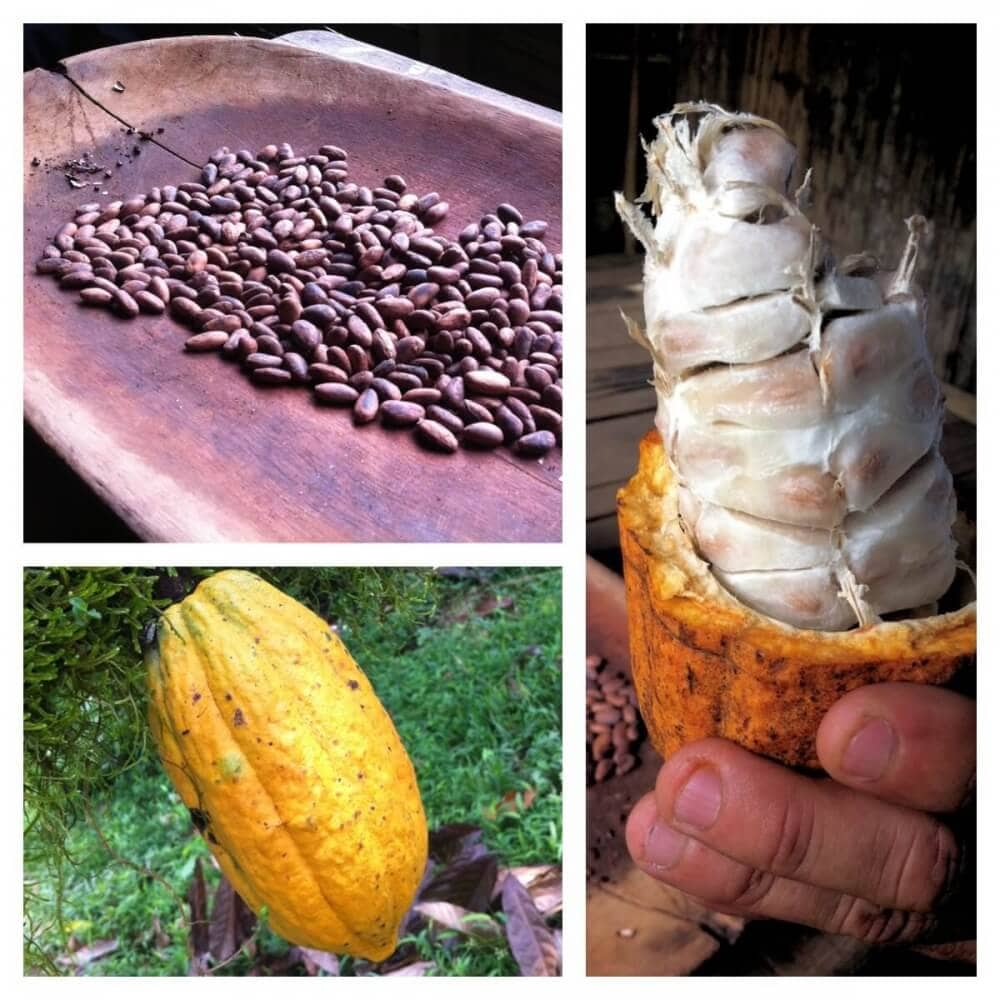
Three stages of cocoa we photographed in Costa Rica. The whole pod on the tree, the white flesh fruit inside, and the roasted seeds (beans) which are then turned into cocoa.
Cocoa Bean: Cocoa beans are the source of chocolate, but the white fruit pulp surrounding the seed is edible too! It tastes very sweet, similar to Ice Cream Bean or Mangosteen. Unfortunately, most of the fruit pulp is discarded in the process of making cocoa. But if you ever get the chance to try raw cacao and taste the fruit that surrounds the seed, give it a try!
The cacao fruit grows directly from the trunk of the tree and takes about 6 months to become ripe. Each fruit has about 20-40 brown cacao seeds inside, which are typically dried and ground to make chocolate. Cacao grows best along the “bean belt” near the equator, so you’ll find it in South America as well as Africa and South East Asia. We had the opportunity to tray raw cocoa beans during a trip to Costa Rica along the Panama Border.
Coconut: Technically, coconuts are considered a nut since they have a hard outer shell. Botanically speaking, they’re known as a dry drupe. But they’re loosely considered a fruit too which is why I have them listed here. Coconut grows on palms in coastal tropical regions of Figi, India, the Philippines, Thailand, and Indonesia. Coconuts taste sweet and creamy and are used in a variety of foods, from sweet desserts to crunchy batters for meat.
Cucamelon: Cucamelons are a cute tropical fruit that looks like tiny little watermelons growing on a climbing vine. They are about the size of a grape and taste like a cucumber. I’ve seen them growing wild in backyards in Florida. But they’re also known as Mexican miniature watermelon, pepquinos, and sour cucumber. You can eat the whole thing fresh from the vine, no need to remove the peel. Some like to even pickle cucamelons or add them to salads, salsas, or even a fun garnish on cocktails.
Dragon Fruit: Also known as pitaya, Dragon Fruit gets its nickname from it’s egg-like shape, bright pink color, and soft spikes on the outer skin. It’s grown on a cactus and can be found in Southeast Asia, Florida, and the Caribbean. The fruit inside can be white or pink, with lots of little seeds and the texture has been compared to kiwifruit. To eat them, you can cut them in half moon shaped slices, use a melon baller to make fun dragon fruit spheres, or simply cut the fruit in half and scoop the fruit out with a spoon.
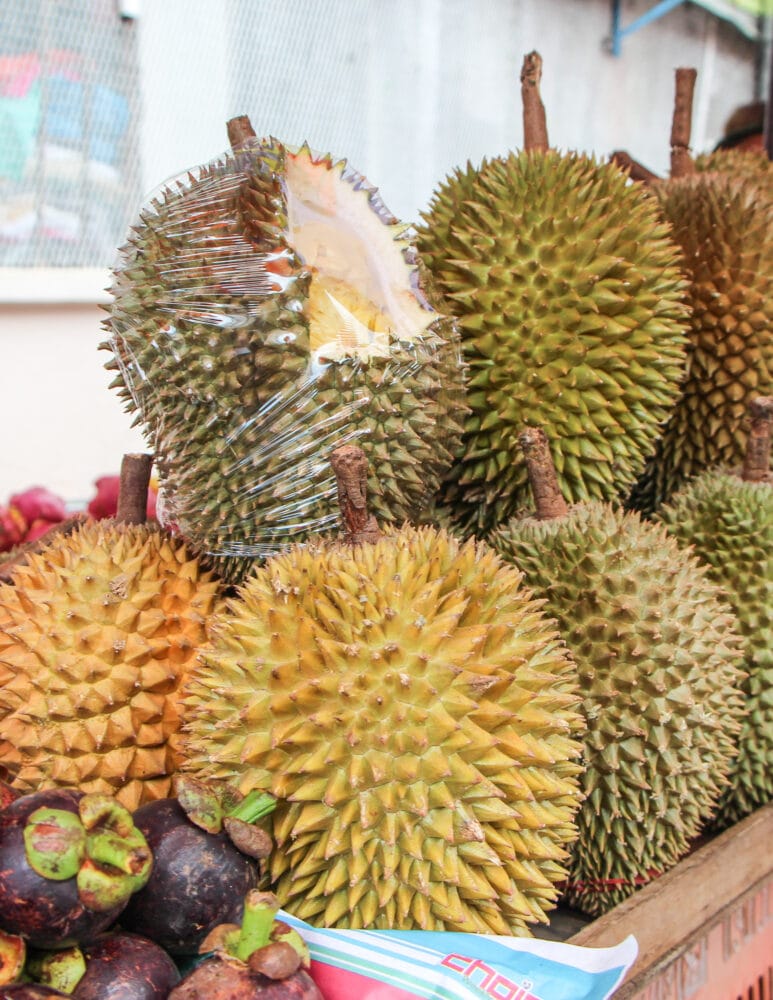
Durian fruit (and a little mangosteen) stacked at a market in Thailand.
Durian: Durian is famous for being the stinkiest fruit on the planet! The scent has been described as onions, foul cheese, and wet gym socks. And the texture is like a soft custard. Personally, after trying it, I didn’t think it was that bad. The trick is to not eat it when it’s too ripe. Due to its overpowering smell, durian has been banned on many types of public transportation and even inside hotels across Thailand, Japan and Hong Kong. If you want to try the flavor, but can’t get access to the fruit, try durian candy instead!
Guanabana / Soursop: This tropical fruit is popular throughout Florida and the Caribbean, and it’s available in southeast Asia too! It has green, spiky skin and a soft white flesh that has a flavor that’s a cross between pineapple and strawberries. It’s common to find it served as a juice or flavored ice pops.
Guaba or Guama: Also, known as Ice Cream Bean, this pod is native to South America. It’s a bit hard to find outside of it’s growing region. The first time I tried it was during a trip to Costa Rica. I kept thinking they were saying “guava” and I thought, “our guava in Florida is nothing like this!” Guaba looks like a long green bean with white cotton like pulp around seeds inside. And it tastes like vanilla ice cream!
Guava: Guava is a common tropical fruit grown in Florida, the Caribbean, and Central and South America. It’s round and green, like a lime, but the inside is pink or yellow. It can even turn maroon or red when ripe. Guava is a popular tropical fruit for sweets, such as guava jelly, drinks, and guava filled pastries. It’s flavor is very unique and somewhat floral, like a cross between a strawberry and a pear.
Hog Plum / Jocote: Hog plums, also called jocote or Spanish Plums, are native to Central America. Though, Spanish explorers brought the fruit to the Philippines to where it’s popular today. The fruit is oddly shaped and start off as green or yellowish-green and then ripen to a purple or red color. The Fruit is sweet with a somewhat bitter aftertaste.
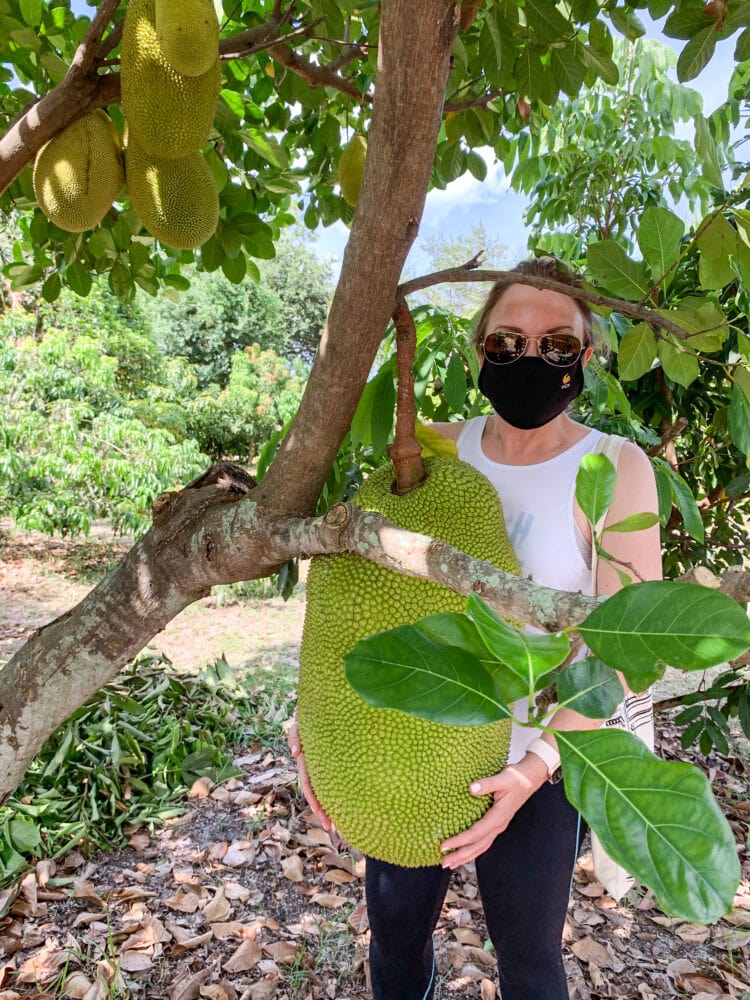
Rachelle standing next to a jackfruit tree holding a jackfruit that is the same size as her torso!
Jack Fruit: Jack Fruit looks a bit like durian mentioned above, but has a less spiky texture. And while durian is the stinkiest fruit, jack fruit is the largest fruit in the world! Some jack fruit has even grown to be over 100 pounds! The fruit grows straight from the trunk of the tree and has a hard outer shell. The fruit inside looks like little yellow “fists” that wrap around the seeds. They’re hard work to open, clean, and get to the fruit. But so worth it.
To me, Jack Fruit tastes a little bit like Juicy Fruit Gum and has a similar texture to bell peppers, though not as crunchy. They’re native to southeast Asia and are popular there in candies and smoothies. Though, they’ve recently become popular in the United States as a form of vegan “pork” when cooked.
Jabuticaba: Also known as a Brazilian Grape Tree, this thick-skinned dark purple fruit is berry-like and looks similar to grapes. The skin is a bit tannic, but the fruit inside is sweet and tastes similar to lychee. Like the jack fruit, jabuticaba is a tropical fruit that grows directly out of the trunk of the tree. The best way to eat them is by breaking a hole in the skin with your teeth and sucking out the fruit inside.
Kaffir Lime: Kaffir lime, or makrut lime, is a citrus fruit native to Asia. The fruit and leaves are very popular in Thai cuisine and the essential oil from the rind is used in perfumeries. But the leaves also have an intense citrus scent, which is why they’re so popular for flavoring dishes. In South Africa, “kaffir” is an ethnic slur, so it’s known there as Thai limes.
Key Lime: Key Limes are tiny, tart, and best used in pies! It’s a citrus hybrid that is picked when green, but becomes yellow when ripe. They have a really strong lime aroma which makes them great for flavoring recipes (like key lime pie!) but they’re too bitter to eat raw.
Kumquat: The kumquat is an edible, orange-like fruit that is native to Southeast Asia. But you’ll find them in Florida too! It resembles a little orange in shape, color, and texture, but kumquats are only about the size of an olive or grape. They’re lightly sweet, but the rind is really sour. You can eat them whole, just wash them and pop them into your mouth to combine the sweet and tart flavors. But they’re best when used for marmalade.
Langsat: This fruit is super rare and hardly seen in the United States. It’s native to Southeast Asia including the southern part of Thailand, Malaysia, and the Phillipieans. The fruit is small and grows in large clusters. The outer skin is light brown, and looks a bit like a potato, but with the shape of longan. But the inside is white and segmented, similar to mangosteen. Langsat tastes bittersweet and citrus-like.
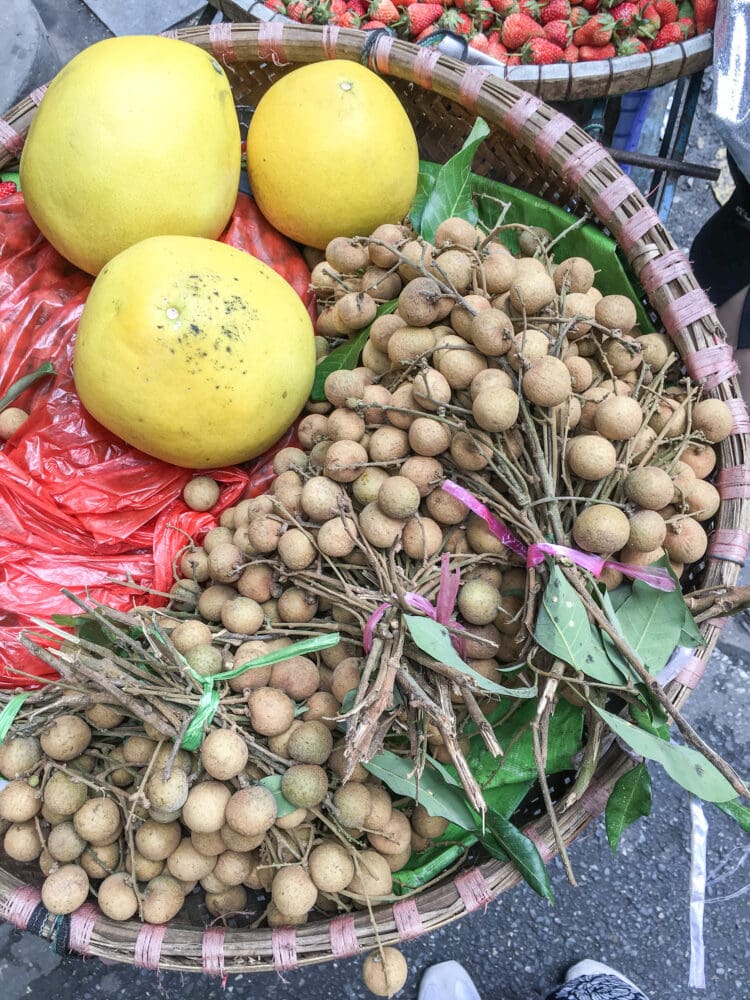
Longan in a market basket in Myanmar.
Longan: Longon is similar to lychee and rambutan, but has a thin greenish tan peel. To eat them, take a small bite of the fruit to crack the hard skin, then peel the rest away and eat the fruit inside. The term longan comes from a Canonese word that means “dragon eye.” The fruit is so named since it resembles an eyeball when the fruit is shelled. They taste a bit more grassy or earthy than lychee and rambutan.
Loquat: Loquats are sometimes confused with kumquats, but they look and taste completely different. They have soft golden skin and are similar in color, texture, and flavor to apricots. However, they’re smaller, pear-shaped, and about the size of a grape. Loquats are originally from China, where the leaves are used for tea. But they’re a popular ornamental plant as well. The fruit is most often used to make jam, jelly, and chutney.
Lychee: Lychee is similar to longan, but has a bumpy pink-ish red skin. The outer skin is rough and inedible, but the fruit inside is sweet and juicy with a hint of floral notes. To eat lychee, peel off the pink rind to get to the fruit. Just be careful of the large seed inside. Lychees are used in a lot of drinks and desserts throughout Asia. You can find them in Central America and Florida too!
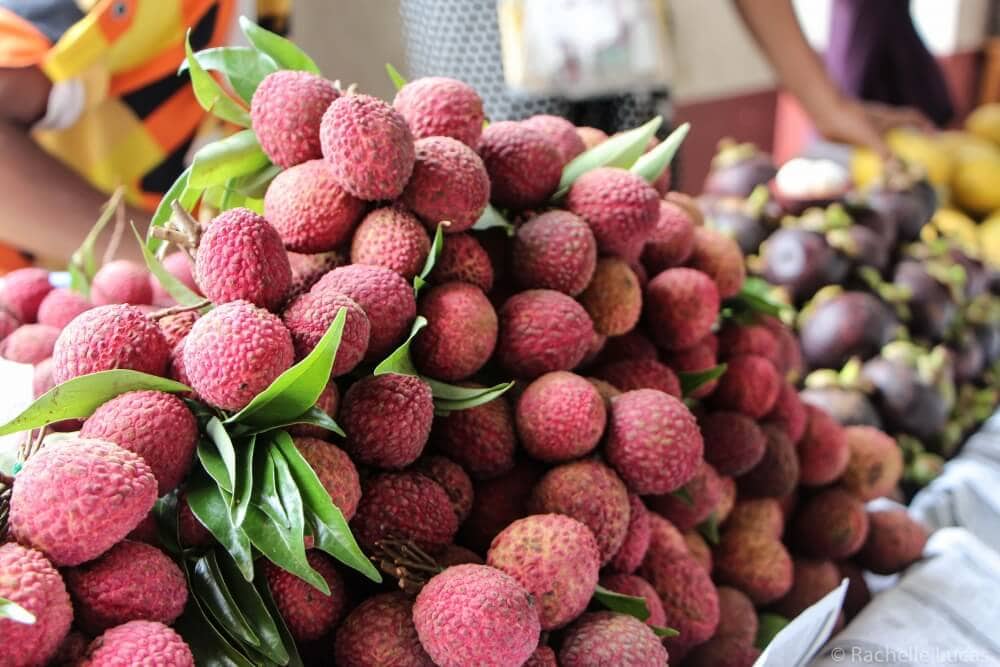
Bright pink lychee fruit stacked in a pyramid at a market in Myanmar.
Mamey Sapote: Mamey sapote is related to sapodilla and black sapote. Mamey sapote has brown skin with a bright orange or salmon colored fruit inside. The texture is creamy and tastes like a cross between sweet potato, persimmon, honey, and apricot. It’s native to Cuba and Central America and can be eaten raw, though it’s most commonly used in ice cream, milkshakes, smoothies, and frozen tropical fruit bars too.
Mamoncillo (Spanish Lime): Spanish Limes are not limes or citrus at all, but are actually related to lychee. They’re also known as mamoncillo or quenepas. The fruit has a tough green skin with juicy light orange flesh that clings to a seed. It tastes both sweet and acidic, kind of like a cross between a lime, lychee, and tamarind. They’re native to Central America and the Caribbean. And in Puerto Rico there’s an annual festival in Ponce celebrating them, the Festival Nacional de la Quenepa.
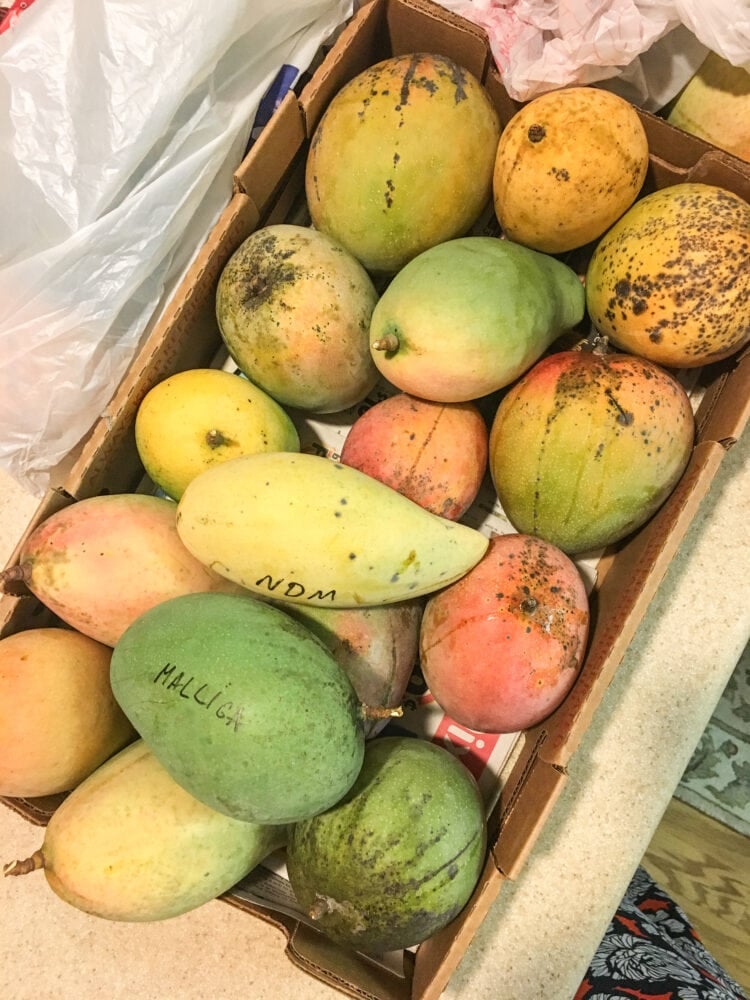
Box full of different varieties of mangoes grown in Florida.
Mango: Mangos are native to south Asia and are the national fruit of India and the Philippines. There are over 100 different varieties, from small to large in size and varying in color from light yellow to pinkish red. Depending on the variety, the flavors are generally sweet with other fruit tones like coconut and pineapple. As for texture, some are buttery smooth and some are more stringy and fibrous. Mangos are most commonly eaten raw, in salads, drinks, or desserts like mango sticky rice.
Mangosteen: Mangosteen is one of the more unique looking fruits. It is small and round, with a purple shell and a little button flower shape stigma on the bottom opposite from the stem. Personally, I think it looks like a dinosaur egg. Usually, the number of “petals” on the stigma will tell you how many seeds are inside. The fruit is a white juice flesh surrounding individual almond-shaped seeds. Mangosteen is commonly known as the “Queen of Fruit” (Durian is the “King of Fruit”) The flavor of mangosteen is so unique that it’s really hard to describe. But I love it! It’s a bit floral and sweet, with a tart aftertaste.
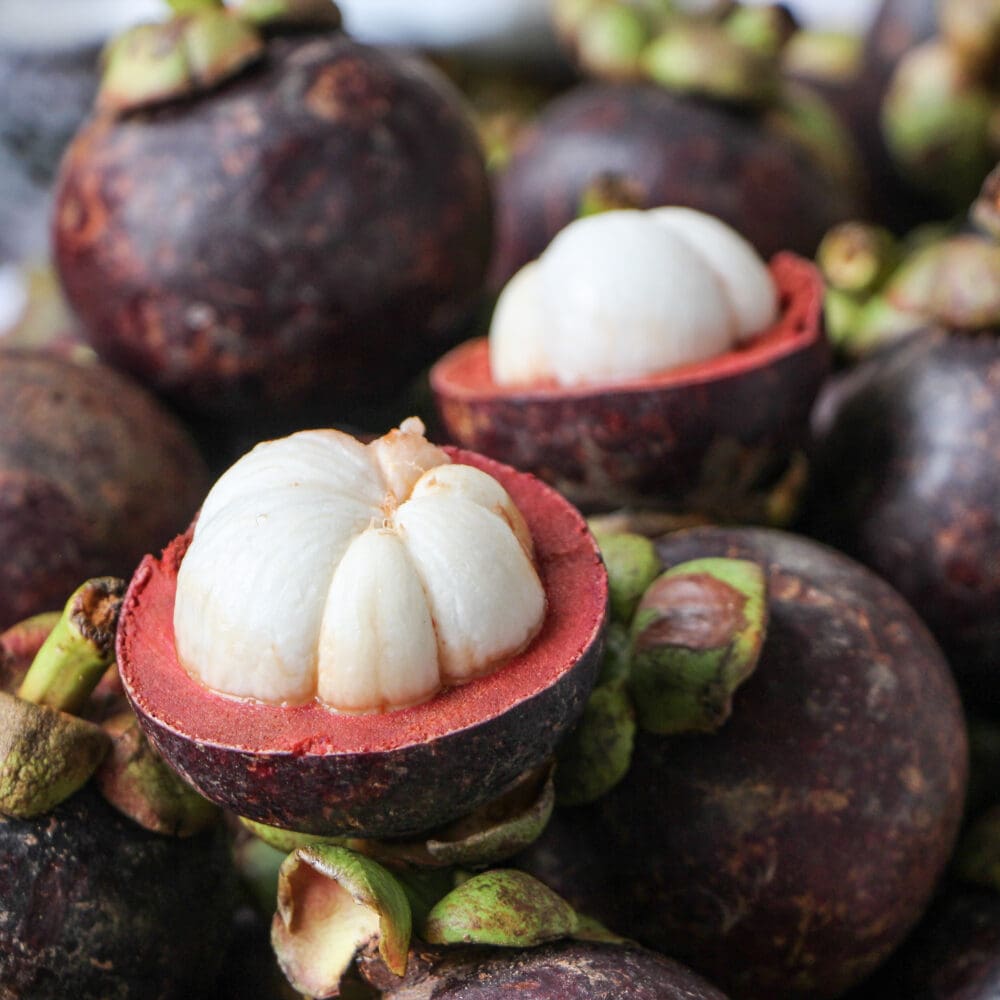
Group of purple Mangosteen fruit with one cut in half so you can see the white fruit sections inside.
Monstera Deliciosa Fruit: Yes, a variety of these super popular house plants produce fruit! The word “monstera” refers to the huge size that this plant can grow to, while deliciosa means “delicious,” referring to the edible fruit. The fruit is long and green, shaped a bit like a pinecone. It has a scent that is like a combo of pineapples and bananas. As for flavor, It’s sometimes called the “Tropical Fruit Salad Plant” because it tastes a bit like just about every fruit that exists. I remember trying one at the Miami Spic Park and later at my in-laws too. I could taste strawberries, bananas, and pineapple all at one. The outer skin can cause some irritation on your tongue and lips, so it’s best not to overindulge. But the flavor is so worth it.
Miracle Fruit: This red berry produces a sort of “miracle” in that it causes sour foods to taste sweet. The effect is due to a chemical in the fruit called miraculin. People who try miracle fruit will immediately consume sour foods like lemons to experience the perceived flavor change. It’s a bit of a good party trick if you can get your hands on some. There’s even tasting events dedicated to this taste-change phenomenon! Miracle fruit is from tropical west africa, though you can also find it in the Caribbean and South Florida as well.
Noni Fruit: Noni Fruit is native to Southeast Asia and is in the same botanical family as coffee. It was made popular due to Noni Juice, but is actually also nicknamed “the vomit fruit” due to its strong smell when it ripens. Thankfully, it does taste different than it smells, but is kind of bland on it’s own which is why it’s typically mixed with other fruits for juicing. It’s also used in curries and in Thai cuisine the leaves are used in a dish called kaeng bai-yo.
Papaya: This green tropical fruit has a bright orange color with a creamy, butter-like texture. It tastes a bit like a cross between a cantaloupe and mando. Papaya is native to Central America and Mexico, but is also now used in Southeast Asian cooking. In Thailand unripe green papayas are used to make a salad called som tam.
Passion Fruit: Passion Fruits are small and round, and can be yellow, red, green, or deep purple in color. They’re quite juicy with numerous seeds, which makes them best for drinks and juices versus eating them raw. Though, you can cut them in half and use a spoon to scoop out and eat the pulp. The flavor is quite tart and tangy, and somewhat perfume-like too. They’re native native to Brazil and South America, although you can find them in some parts of the United States too.
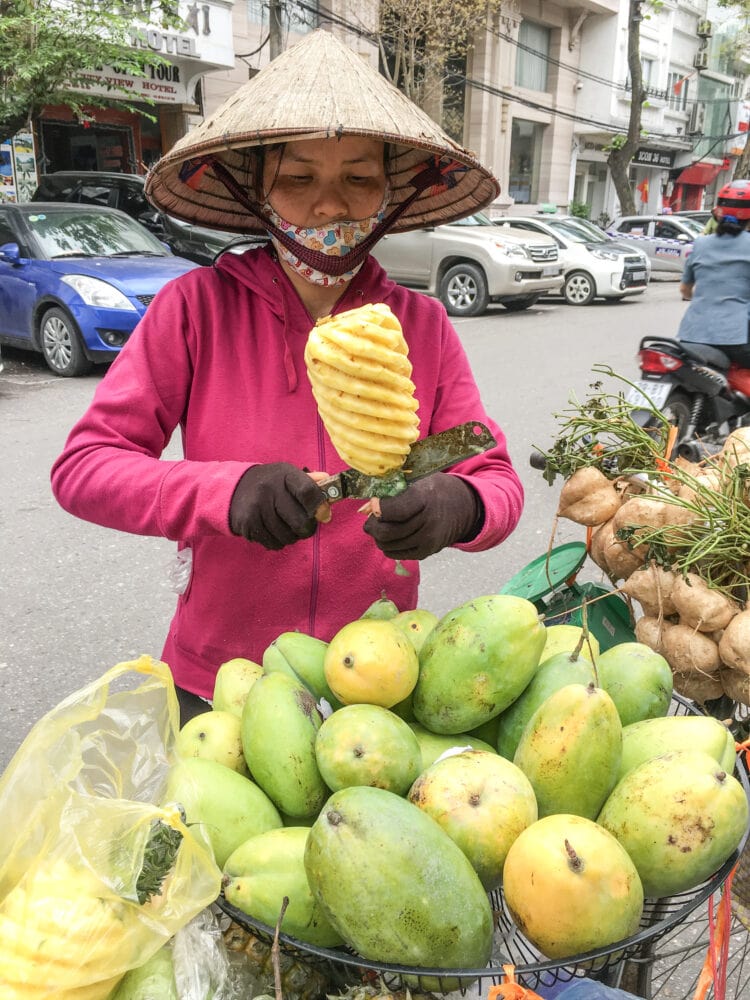
Woman wearing conical hat carving mango on the streets of Hanoi.
Pineapple: Pineapples are the third most popular tropical fruit in the world! They actually grow from a small bromeliad shrub. And, if you save the green tuft cut away from the top of the tough yellow fruit, you can plant it and grow your own (if you live in the right climate, of course.) Pineapples are native to South America, but are also grown throughout the world including Hawaii and the Philippines. Throughout Asia, pineapple is prepared and sold on roadsides as a snack. Some are on skewers, some are sliced and put into clear bags with a side of sugar and ground chili for dipping. They’re also used in cocktails and to decorate hams. But as for pineapple pizza, that’s a big debate.
Plantains: Plantains are similar to bananas, but they’re larger in size and more starchy. Because of their starchiness, plantains are typically enjoyed cooked rather than eaten raw. When cooked, they are a bit like potatoes! In Latin American and Caribbean cuisine, there are tostones, which are green plantains that are fried twice. Some are as thin as chips, and others are more thick and potato-like. There’s also maduros, which are sweet ripe plantains that are pan fried, sometimes even with a little sugar that gives them a flavorful crispy edge.
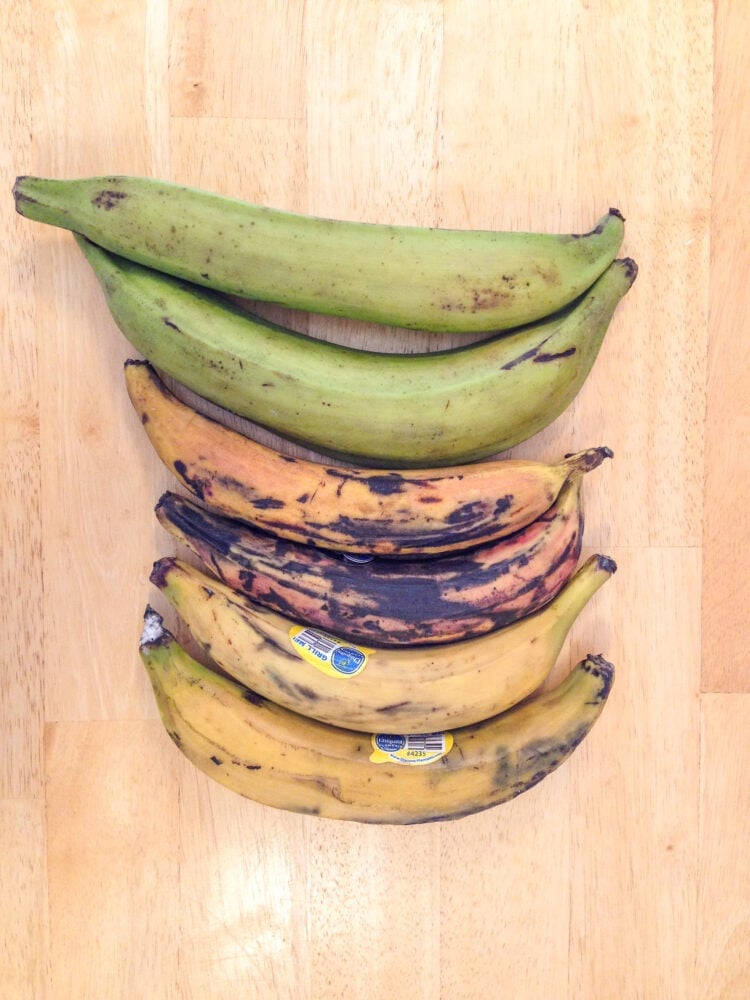
Six plantains showing varying degrees of ripeness, from green, to overripe, to yellow.
Pomelo: Pomelos are one of the largest citrus fruits in the world. They are often compared to grapefruits, but their rind is thicker and the flavor is more mild. Pomelos are shaped a bit like a teardrop, are yellow or light green in color, and grow to be about the size of a cantaloupe or larger. They’re originally from Asia, but grow now in multiple parts of the world and are fairly easy to find in the southern United States.
Rambutan: My husband and I like to call rambutan “punk rock lychee.” The fruit inside is similar in flavor to lychee, but the outer shell is hot pink with green-tipped spikes. It’s one of my favorite tropical fruits! The name comes from the Malay word for “hairy.” Rambutan is native to Asia, but we usually get them in the United States imported from Honduras and Central America.
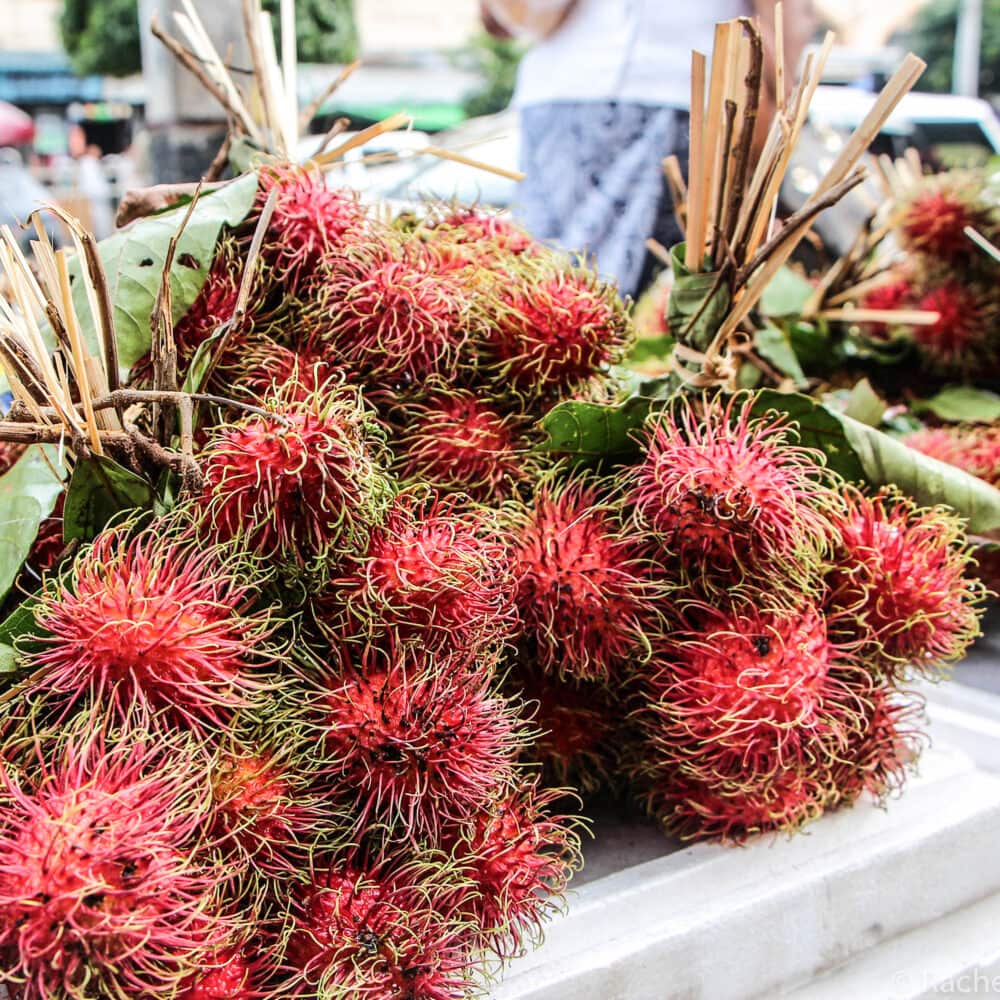
Bouquets of hot pink spiky rambutan fruit tied together and stacked at a market in Myanmar.
Rose Apples: These are my husband’s favorite fruit. Also called a Java Apple, Wax Apple, or “Chompoo” in Thailand, rose apples are actually native to the East Indies. They’re not what you’d typically think of as an apple as they have a waxy appearance and a bell shape similar to a pear. The skin is thin and edible and comes in a variety of colors from white, to green, to light red, and even pink. The fruit is crisp, juicy, and refreshing with a mild sweet flavor.
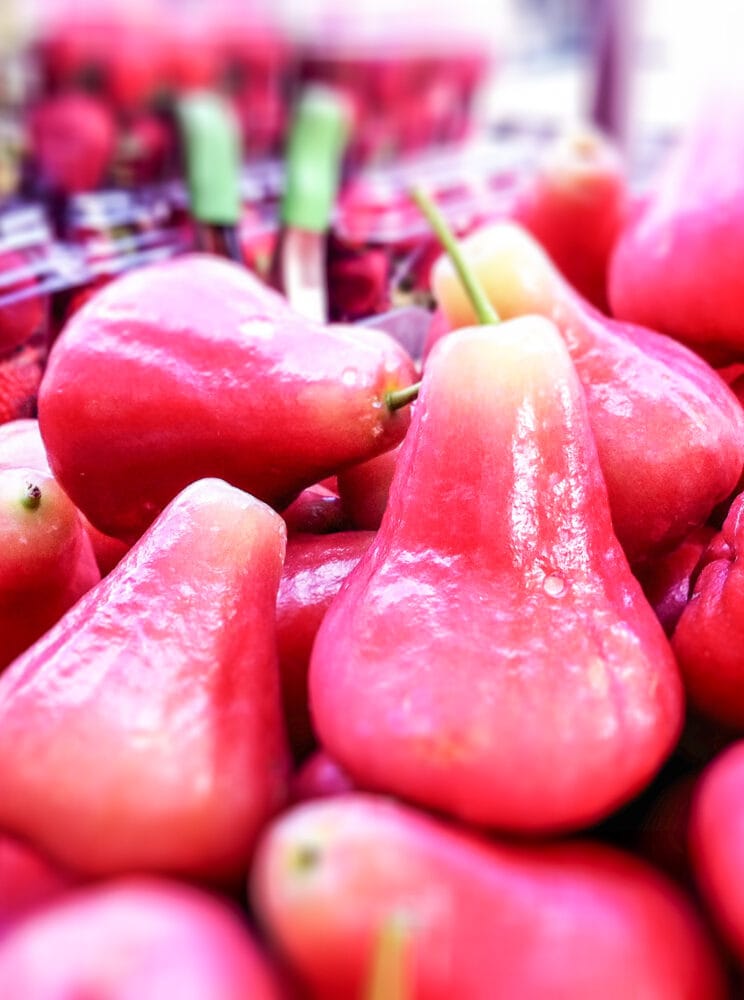
Pink Roseapples stacked at a farmer’s market.
Santol: Santol is a kind of wild mangosteen that’s alls called cotton fruit. It has a sweet and sour flavor and tastes similar to a peach. In Thailand, santol is served cold with a sweet syrup as a type of refreshing dessert. It is native to tropical regions throughout Asia, but can also be found in many parts of Central America too.
Sapodilla: Sapodilla is a very sweet dessert-like fruit in that it taste just like a spoonful of brown sugar. The sapodilla is native to Central America and the Caribbean, though you can find them in Florida too. It’s shaped like a large egg and has light tan skin, that when it starts to get soft, it’s ready to eat.
Snake Fruit: The first time I saw snake fruit was in Bali. Nicknamed after it’s brown, snake-like skin, it didn’t look edible at first. Native to Indonesia, and grows in clusters on salek palm trees. It’s flavor is sweet, a bit like honey, but there’s a tanic acidity to them that’s similar to black tea and makes you pucker.
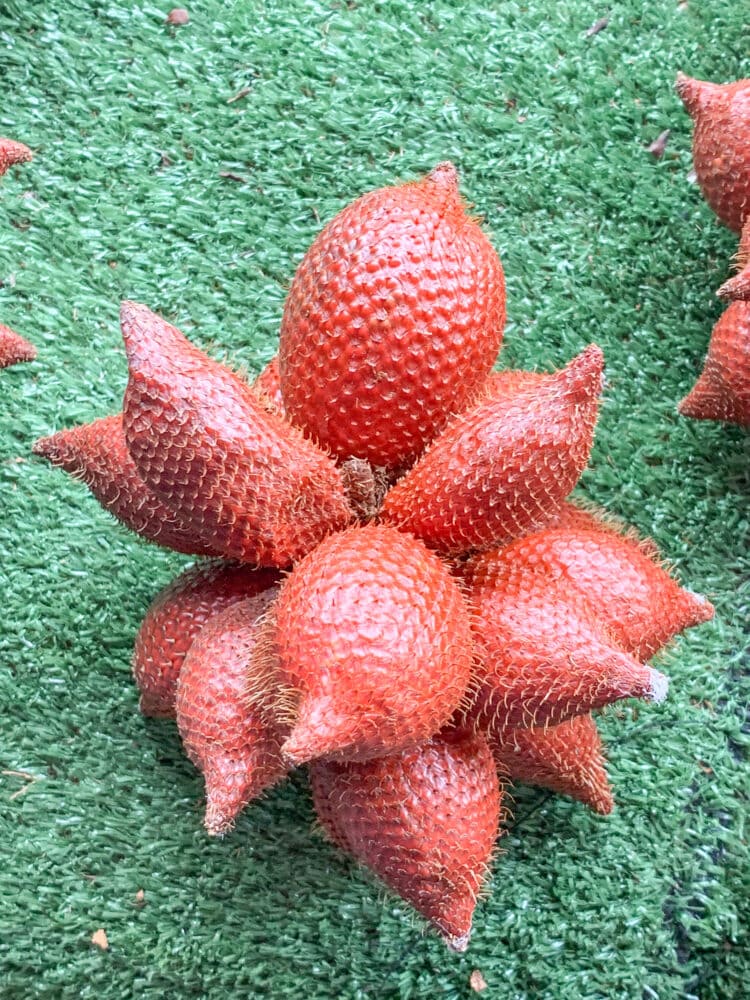
A bunch of snake fruit with brown scaly skin on a green mat at a fruit market.
Sugar Apple: The sugar apple is a bumpy, green fruit with a creamy white flesh that’s fragrant and looks and tastes like custard. It’s native to Central and South America as well as the West Indies. But in Brazil the name used in Portuguese is ata.
Starfruit / Carambola: native to southeast asia and a has a light sweet flavor, similar to citrus, but not as acidic. Usually green until ripe, and then they turn yellow or pale orange. They get their name from resembling star shapes when sliced.
Tamarind: Tamarind is indiginous to tropical Africa, but is also found in Central and South America. It’s a pod-like fruit that tastes sweet and tangy. It’s most commonly used in recipes as a tamarind paste in barbeque sauces, marinades (like Worcestershire sauce), and it’s also used in candies and desserts.
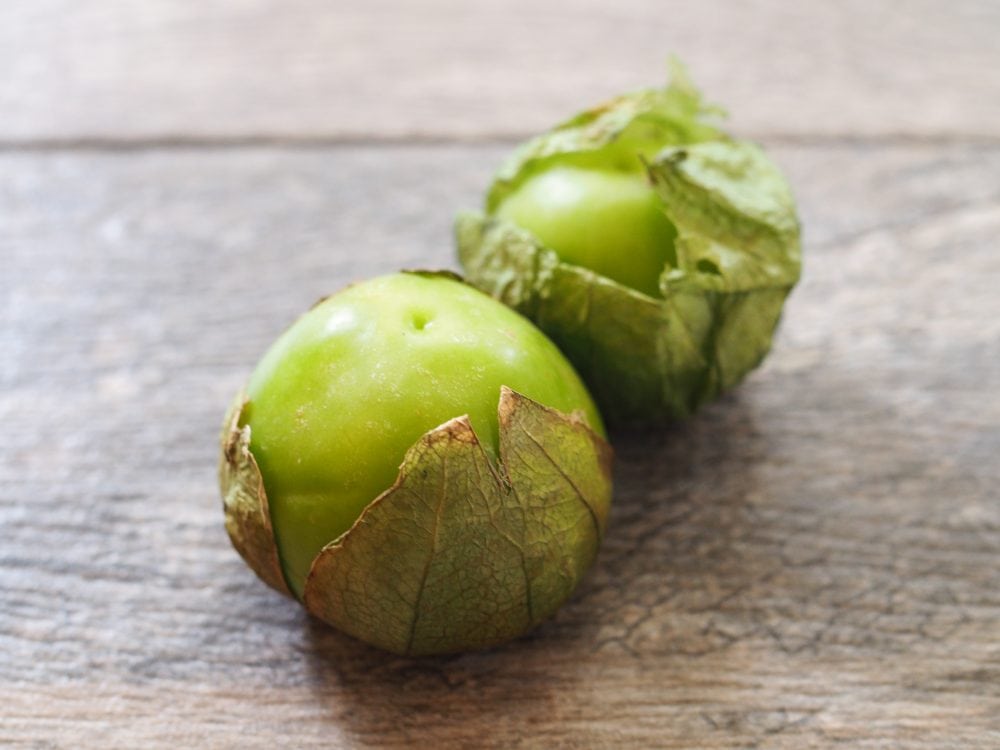
Whole green tomatillos with their papery sheath still attached.
Tomatillo: You might have tried tomatillos in a savory salsa verde, but did you know they were a tropical fruit? Native to Mexico, you’ll find tomatillos included in Mexican cuisine such as salsas, stews, and more. Tomatillos round, light green in color, and are covered in a papery husk.
Velvet Apple: Velvet Apples, also known as Mabolo or Butter Fruit, is a tropical fruit related to the persimmon. But they’re more closely related botanically to the black sapote. Native to the Philippines and Taiwan, Velvet Apples got their nickname from the fine soft peach-like hair on their skin. I’ve not personally tried one, but I’ve read from produce growers that they taste a bit like bubble gum or a banana flavored apple.

Leave a Reply